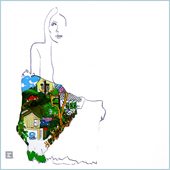In terms of pure form (and even without reference to the depth, sophistication and intelligence conveyed in her work), Joni Mitchell's texts and their discovery provide an absolute pleasure and engender a sense of wonder that never wavers. The language is beautiful, and it is no coincidence that some of these texts and poems were included in College and University studies in the United States during the 1970s. By contrast, our age of Reality Show's disposable and prefab icons whose fame lasts ten minute, and of regiments of "Cell phone zombies babbling through the shopping malls" (Bad Dreams / Shine, 2007), makes today's Pop music sound like some "Junk food for juveniles" (Taming the Tiger, Taming the Tiger 1992).
I shall not attempt to make a listing of the texts most representative of this excellence. Every album by Joni Mitchell, from the first Song for a Seagull (1968) to her last studio release (Shine, 2007) is rich with its own share of nuggets. Of course, the poetic prose running the totality of Hejira (1977), a poetry woven throughout the nine stunning pieces constituting the album, is arguably most entitled to symbolize the best of this excellence.
However, as far as depth and language skills are concerned, texts as distant from each other both chronologically and thematically as Come in From the Cold, The Beat of Black Wings, The Sire of Sorrow (Job's Sad Song), Don Juan's Reckless Daughter, The Jungle Line, People's Parties, Dog Eat Dog, Shine, Judgment from the Moon & Stars, Passion Play (When All The Slaves Are Free), Goodbye Pork Pie Hat, Otis & Marlena, The Boho Dance ou Chinese Cafe, are in no way inferior to the peaks scaled in the compositions of Hejira.
Despite the passage of time, the literary merits of Joni Mitchell's work remain unique, timeless and amazingly powerful. In addition, this work's musical aspect gains at least two extra dimensions (the quintessential splendor of Mitchell's music needs not to be emphasized much more at that stage, being recognized and celebrated the way it is worldwide).
This first of these dimensions relates to an outsider's guitar playing, characterized by the technique of "Open Tuning" -that is, a non-traditional way of tuning one's guitar. Joni Mitchell gives her instrument a tonality so original that it cannot be mistaken for any other.
A "Joni Mitchell sound" was thus imposed, incisive and wide in terms of both melody and sharpness, and always attractive though, in spite of its eminently disconcerting tones. Silky Veils of Ardour in Don Juan's Reckless Daughter (1977) stands out as a perfect example among Mitchell's other noticeable guitar renditions, such as The Wolf That Lives In Lindsey (Mingus, 1989), or If en 2007 (last track of the Shine album).
It is that famous "Open Tuning" that caused the row with Furry Lewis, the old Bluesman in Memphis who was in his nineties when Mitchell finally met him. Lewis enjoined her to leave because she had dared raise their common point, namely this famous and mysterious "Open Tuning" chord…
The old Bluesman obviously did not like to be reminded this particularity, although his overall reasons remain less than obvious –quite obscure to say the least! Nevertheless, the interview ended abruptly, with Lewis' loud and resounding "I don't like you" directed at the blonde musician (Furry Sings The Blues in Hejira, 1976).
© Jacques Benoit. Design, works, photographies and texts by Jacques Benoit and under the author’s copyright. Except when derived from other sources and then mentioned as such.

